Logistics and Supply Chain Management - Characteristics of an Intermodal Company and Solutions to Associated Problems
VerifiedAdded on 2023/06/08
|13
|4057
|178
AI Summary
This report discusses the characteristics of an intermodal company and the problems associated with the location of the intermodal company. It also provides solutions and recommendations to address the problems. The report covers the challenges faced by the logistics network in New South Wales and the solutions to overcome them.
Contribute Materials
Your contribution can guide someone’s learning journey. Share your
documents today.

Running head: LOGISTICS AND SUPPLY CHAIN
ogistics and supply chain managementL
Name of Student:
Name of College:
Authors Note:
1 | P a g e
ogistics and supply chain managementL
Name of Student:
Name of College:
Authors Note:
1 | P a g e
Secure Best Marks with AI Grader
Need help grading? Try our AI Grader for instant feedback on your assignments.
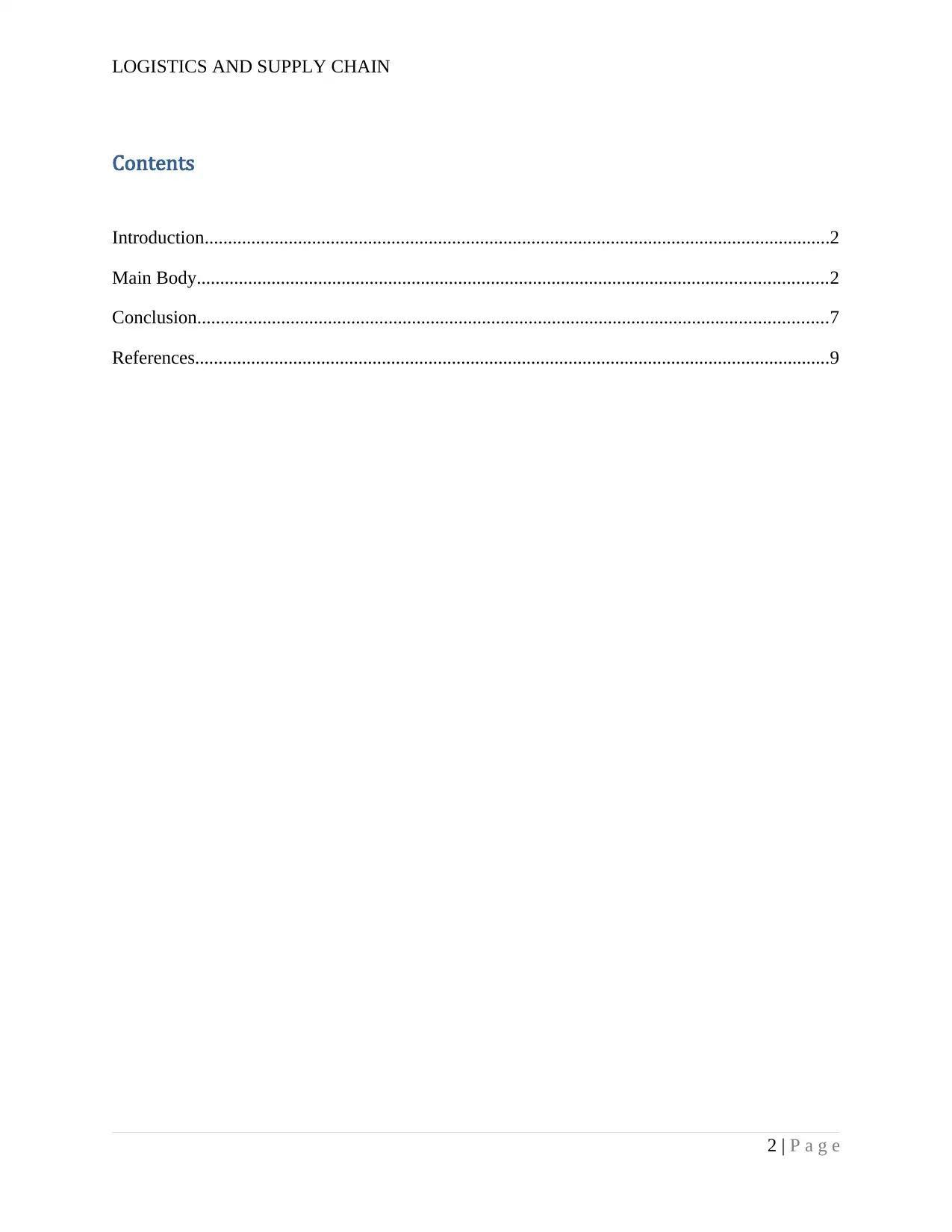
LOGISTICS AND SUPPLY CHAIN
Contents
Introduction......................................................................................................................................2
Main Body.......................................................................................................................................2
Conclusion.......................................................................................................................................7
References........................................................................................................................................9
2 | P a g e
Contents
Introduction......................................................................................................................................2
Main Body.......................................................................................................................................2
Conclusion.......................................................................................................................................7
References........................................................................................................................................9
2 | P a g e
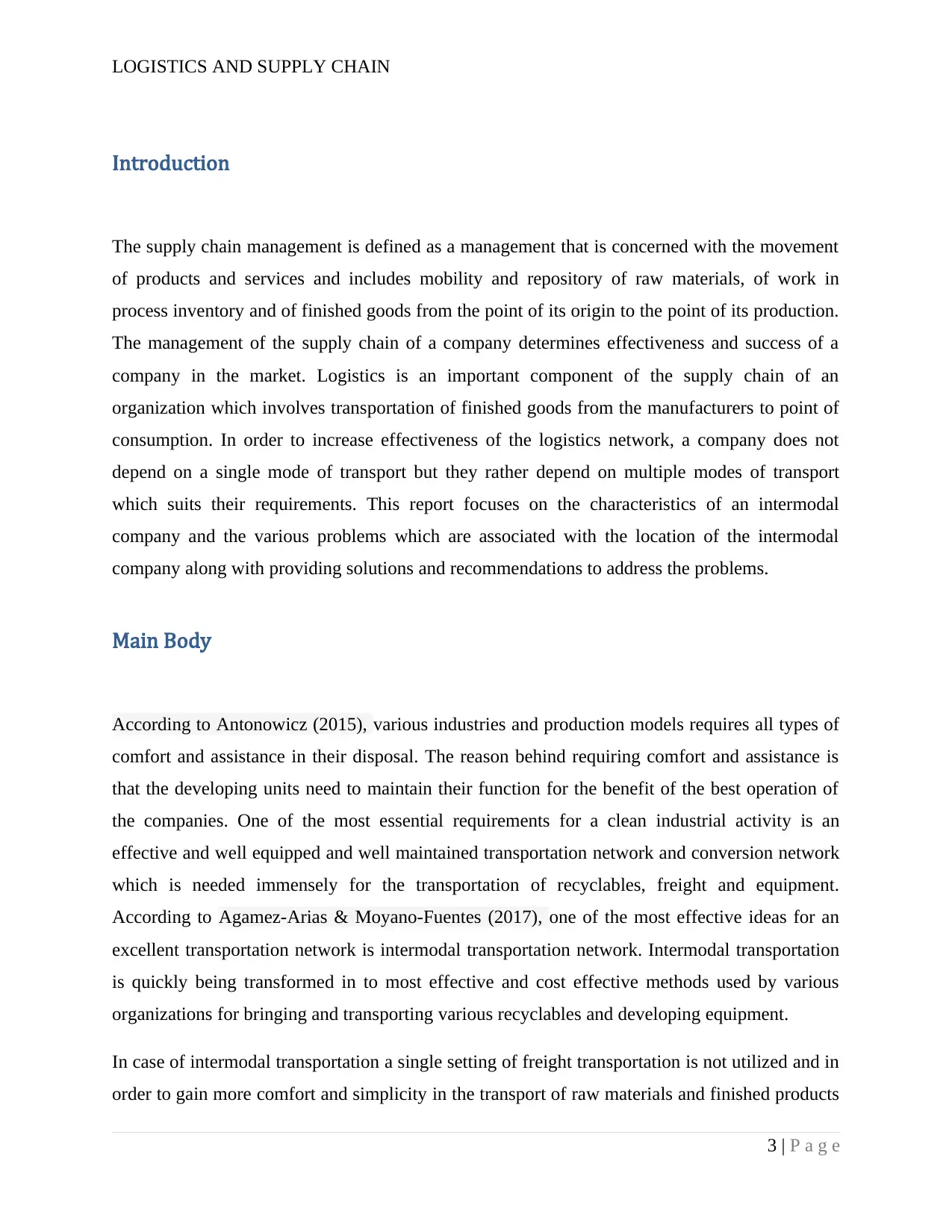
LOGISTICS AND SUPPLY CHAIN
Introduction
The supply chain management is defined as a management that is concerned with the movement
of products and services and includes mobility and repository of raw materials, of work in
process inventory and of finished goods from the point of its origin to the point of its production.
The management of the supply chain of a company determines effectiveness and success of a
company in the market. Logistics is an important component of the supply chain of an
organization which involves transportation of finished goods from the manufacturers to point of
consumption. In order to increase effectiveness of the logistics network, a company does not
depend on a single mode of transport but they rather depend on multiple modes of transport
which suits their requirements. This report focuses on the characteristics of an intermodal
company and the various problems which are associated with the location of the intermodal
company along with providing solutions and recommendations to address the problems.
Main Body
According to Antonowicz (2015), various industries and production models requires all types of
comfort and assistance in their disposal. The reason behind requiring comfort and assistance is
that the developing units need to maintain their function for the benefit of the best operation of
the companies. One of the most essential requirements for a clean industrial activity is an
effective and well equipped and well maintained transportation network and conversion network
which is needed immensely for the transportation of recyclables, freight and equipment.
According to Agamez-Arias & Moyano-Fuentes (2017), one of the most effective ideas for an
excellent transportation network is intermodal transportation network. Intermodal transportation
is quickly being transformed in to most effective and cost effective methods used by various
organizations for bringing and transporting various recyclables and developing equipment.
In case of intermodal transportation a single setting of freight transportation is not utilized and in
order to gain more comfort and simplicity in the transport of raw materials and finished products
3 | P a g e
Introduction
The supply chain management is defined as a management that is concerned with the movement
of products and services and includes mobility and repository of raw materials, of work in
process inventory and of finished goods from the point of its origin to the point of its production.
The management of the supply chain of a company determines effectiveness and success of a
company in the market. Logistics is an important component of the supply chain of an
organization which involves transportation of finished goods from the manufacturers to point of
consumption. In order to increase effectiveness of the logistics network, a company does not
depend on a single mode of transport but they rather depend on multiple modes of transport
which suits their requirements. This report focuses on the characteristics of an intermodal
company and the various problems which are associated with the location of the intermodal
company along with providing solutions and recommendations to address the problems.
Main Body
According to Antonowicz (2015), various industries and production models requires all types of
comfort and assistance in their disposal. The reason behind requiring comfort and assistance is
that the developing units need to maintain their function for the benefit of the best operation of
the companies. One of the most essential requirements for a clean industrial activity is an
effective and well equipped and well maintained transportation network and conversion network
which is needed immensely for the transportation of recyclables, freight and equipment.
According to Agamez-Arias & Moyano-Fuentes (2017), one of the most effective ideas for an
excellent transportation network is intermodal transportation network. Intermodal transportation
is quickly being transformed in to most effective and cost effective methods used by various
organizations for bringing and transporting various recyclables and developing equipment.
In case of intermodal transportation a single setting of freight transportation is not utilized and in
order to gain more comfort and simplicity in the transport of raw materials and finished products
3 | P a g e

LOGISTICS AND SUPPLY CHAIN
various companies and firms utilize utilizes multiple setting and modes of transportation. As
stated by Mostert & Limbourg (2016), the intermodal transport for various sectors and
manufacturing models comprises of multiple choices of modes of transport. In most of the cases
the intermodal trucking business forms the preliminary section of the vast intermodal procedure.
As stated by Reis (2014), in various developed countries and economies, road transportation in
the form of trucks is the well-preferred way of transportation and shifting of raw materials and
goods over long distances. But in addition to road transportation in the form of trucks, companies
also utilizes railway network in order to transport raw materials and finished goods. According to
Caris et al. (2013), apart from road and rail transport networks, various companies also utilize
other modes of transport such as airways and waterways so as to receive as well as transport raw
materials and finished products from one location to the other. As opined by Bhattacharya et. al.
(2014), in most of the cases the various modes of transport are used by the company in the form
of transit centres and hubs for receiving and transporting raw materials and finished products
from one location to the other.
The lean tool has been derived from the concept of lean manufacturing concept and the tool
helps follows a set of principles in order to achieve quality, speed and customer alignment. The
main aim of the lean tool is eliminate those elements which are not helping to add any sort of
values to the work and focusing on the elements which are required in the supply chain at the
current time. According to Ghobakhloo& Azar (2018) the elimination of waste in the lean tool
refers to not only the removal of un-necessary tasks, meetings and documentation but it also
refers to elimination of time which are spent in future planning and forecasting as the market is
constantly changing and therefore the time spent in planning the future elements often appear to
be a waste of time. The lean tool also eliminates the concept of ineffective methods of working
such as multitasking, and therefore the delivery network of the company practising lean
manufacturing becomes fast in nature. The concept of lean tool also helps in focusing on system
which is defined as the way the team of an organization operates as a whole. Organizations
which implement the lean tool in their operations enjoys a strong competitive advantage in the
market in which it operates as they have the ability to successfully respond to changes in the
market by not trying to predict the future.
4 | P a g e
various companies and firms utilize utilizes multiple setting and modes of transportation. As
stated by Mostert & Limbourg (2016), the intermodal transport for various sectors and
manufacturing models comprises of multiple choices of modes of transport. In most of the cases
the intermodal trucking business forms the preliminary section of the vast intermodal procedure.
As stated by Reis (2014), in various developed countries and economies, road transportation in
the form of trucks is the well-preferred way of transportation and shifting of raw materials and
goods over long distances. But in addition to road transportation in the form of trucks, companies
also utilizes railway network in order to transport raw materials and finished goods. According to
Caris et al. (2013), apart from road and rail transport networks, various companies also utilize
other modes of transport such as airways and waterways so as to receive as well as transport raw
materials and finished products from one location to the other. As opined by Bhattacharya et. al.
(2014), in most of the cases the various modes of transport are used by the company in the form
of transit centres and hubs for receiving and transporting raw materials and finished products
from one location to the other.
The lean tool has been derived from the concept of lean manufacturing concept and the tool
helps follows a set of principles in order to achieve quality, speed and customer alignment. The
main aim of the lean tool is eliminate those elements which are not helping to add any sort of
values to the work and focusing on the elements which are required in the supply chain at the
current time. According to Ghobakhloo& Azar (2018) the elimination of waste in the lean tool
refers to not only the removal of un-necessary tasks, meetings and documentation but it also
refers to elimination of time which are spent in future planning and forecasting as the market is
constantly changing and therefore the time spent in planning the future elements often appear to
be a waste of time. The lean tool also eliminates the concept of ineffective methods of working
such as multitasking, and therefore the delivery network of the company practising lean
manufacturing becomes fast in nature. The concept of lean tool also helps in focusing on system
which is defined as the way the team of an organization operates as a whole. Organizations
which implement the lean tool in their operations enjoys a strong competitive advantage in the
market in which it operates as they have the ability to successfully respond to changes in the
market by not trying to predict the future.
4 | P a g e
Secure Best Marks with AI Grader
Need help grading? Try our AI Grader for instant feedback on your assignments.
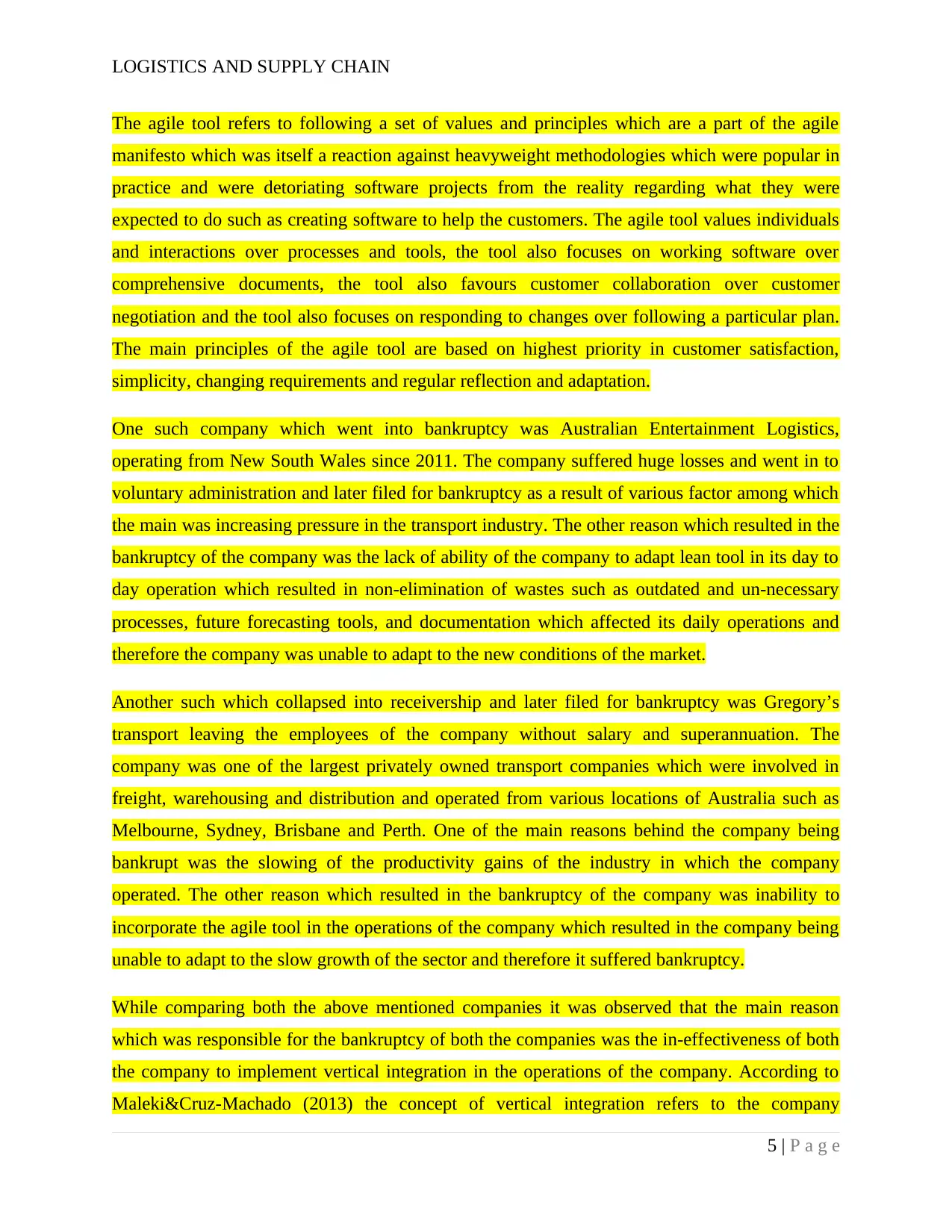
LOGISTICS AND SUPPLY CHAIN
The agile tool refers to following a set of values and principles which are a part of the agile
manifesto which was itself a reaction against heavyweight methodologies which were popular in
practice and were detoriating software projects from the reality regarding what they were
expected to do such as creating software to help the customers. The agile tool values individuals
and interactions over processes and tools, the tool also focuses on working software over
comprehensive documents, the tool also favours customer collaboration over customer
negotiation and the tool also focuses on responding to changes over following a particular plan.
The main principles of the agile tool are based on highest priority in customer satisfaction,
simplicity, changing requirements and regular reflection and adaptation.
One such company which went into bankruptcy was Australian Entertainment Logistics,
operating from New South Wales since 2011. The company suffered huge losses and went in to
voluntary administration and later filed for bankruptcy as a result of various factor among which
the main was increasing pressure in the transport industry. The other reason which resulted in the
bankruptcy of the company was the lack of ability of the company to adapt lean tool in its day to
day operation which resulted in non-elimination of wastes such as outdated and un-necessary
processes, future forecasting tools, and documentation which affected its daily operations and
therefore the company was unable to adapt to the new conditions of the market.
Another such which collapsed into receivership and later filed for bankruptcy was Gregory’s
transport leaving the employees of the company without salary and superannuation. The
company was one of the largest privately owned transport companies which were involved in
freight, warehousing and distribution and operated from various locations of Australia such as
Melbourne, Sydney, Brisbane and Perth. One of the main reasons behind the company being
bankrupt was the slowing of the productivity gains of the industry in which the company
operated. The other reason which resulted in the bankruptcy of the company was inability to
incorporate the agile tool in the operations of the company which resulted in the company being
unable to adapt to the slow growth of the sector and therefore it suffered bankruptcy.
While comparing both the above mentioned companies it was observed that the main reason
which was responsible for the bankruptcy of both the companies was the in-effectiveness of both
the company to implement vertical integration in the operations of the company. According to
Maleki&Cruz-Machado (2013) the concept of vertical integration refers to the company
5 | P a g e
The agile tool refers to following a set of values and principles which are a part of the agile
manifesto which was itself a reaction against heavyweight methodologies which were popular in
practice and were detoriating software projects from the reality regarding what they were
expected to do such as creating software to help the customers. The agile tool values individuals
and interactions over processes and tools, the tool also focuses on working software over
comprehensive documents, the tool also favours customer collaboration over customer
negotiation and the tool also focuses on responding to changes over following a particular plan.
The main principles of the agile tool are based on highest priority in customer satisfaction,
simplicity, changing requirements and regular reflection and adaptation.
One such company which went into bankruptcy was Australian Entertainment Logistics,
operating from New South Wales since 2011. The company suffered huge losses and went in to
voluntary administration and later filed for bankruptcy as a result of various factor among which
the main was increasing pressure in the transport industry. The other reason which resulted in the
bankruptcy of the company was the lack of ability of the company to adapt lean tool in its day to
day operation which resulted in non-elimination of wastes such as outdated and un-necessary
processes, future forecasting tools, and documentation which affected its daily operations and
therefore the company was unable to adapt to the new conditions of the market.
Another such which collapsed into receivership and later filed for bankruptcy was Gregory’s
transport leaving the employees of the company without salary and superannuation. The
company was one of the largest privately owned transport companies which were involved in
freight, warehousing and distribution and operated from various locations of Australia such as
Melbourne, Sydney, Brisbane and Perth. One of the main reasons behind the company being
bankrupt was the slowing of the productivity gains of the industry in which the company
operated. The other reason which resulted in the bankruptcy of the company was inability to
incorporate the agile tool in the operations of the company which resulted in the company being
unable to adapt to the slow growth of the sector and therefore it suffered bankruptcy.
While comparing both the above mentioned companies it was observed that the main reason
which was responsible for the bankruptcy of both the companies was the in-effectiveness of both
the company to implement vertical integration in the operations of the company. According to
Maleki&Cruz-Machado (2013) the concept of vertical integration refers to the company
5 | P a g e
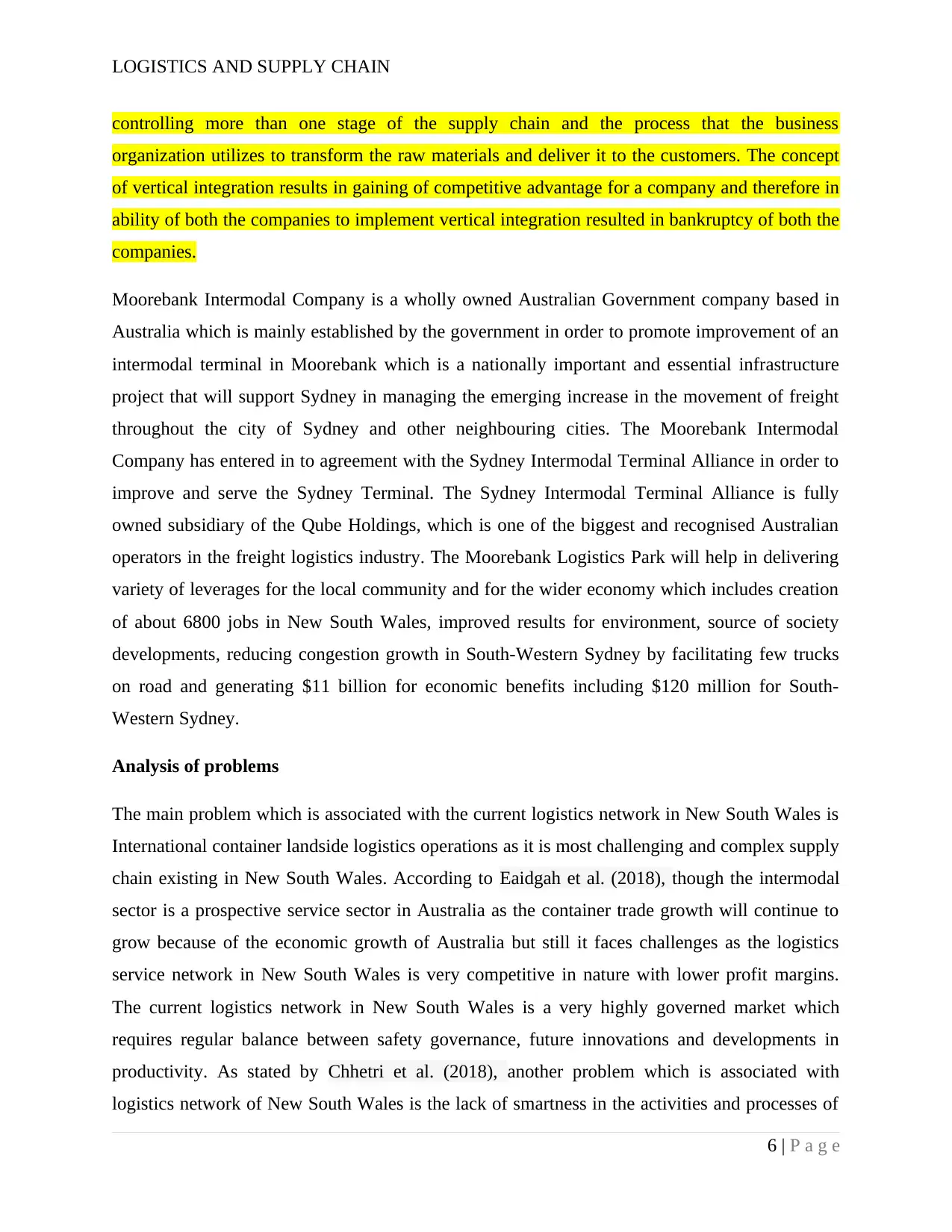
LOGISTICS AND SUPPLY CHAIN
controlling more than one stage of the supply chain and the process that the business
organization utilizes to transform the raw materials and deliver it to the customers. The concept
of vertical integration results in gaining of competitive advantage for a company and therefore in
ability of both the companies to implement vertical integration resulted in bankruptcy of both the
companies.
Moorebank Intermodal Company is a wholly owned Australian Government company based in
Australia which is mainly established by the government in order to promote improvement of an
intermodal terminal in Moorebank which is a nationally important and essential infrastructure
project that will support Sydney in managing the emerging increase in the movement of freight
throughout the city of Sydney and other neighbouring cities. The Moorebank Intermodal
Company has entered in to agreement with the Sydney Intermodal Terminal Alliance in order to
improve and serve the Sydney Terminal. The Sydney Intermodal Terminal Alliance is fully
owned subsidiary of the Qube Holdings, which is one of the biggest and recognised Australian
operators in the freight logistics industry. The Moorebank Logistics Park will help in delivering
variety of leverages for the local community and for the wider economy which includes creation
of about 6800 jobs in New South Wales, improved results for environment, source of society
developments, reducing congestion growth in South-Western Sydney by facilitating few trucks
on road and generating $11 billion for economic benefits including $120 million for South-
Western Sydney.
Analysis of problems
The main problem which is associated with the current logistics network in New South Wales is
International container landside logistics operations as it is most challenging and complex supply
chain existing in New South Wales. According to Eaidgah et al. (2018), though the intermodal
sector is a prospective service sector in Australia as the container trade growth will continue to
grow because of the economic growth of Australia but still it faces challenges as the logistics
service network in New South Wales is very competitive in nature with lower profit margins.
The current logistics network in New South Wales is a very highly governed market which
requires regular balance between safety governance, future innovations and developments in
productivity. As stated by Chhetri et al. (2018), another problem which is associated with
logistics network of New South Wales is the lack of smartness in the activities and processes of
6 | P a g e
controlling more than one stage of the supply chain and the process that the business
organization utilizes to transform the raw materials and deliver it to the customers. The concept
of vertical integration results in gaining of competitive advantage for a company and therefore in
ability of both the companies to implement vertical integration resulted in bankruptcy of both the
companies.
Moorebank Intermodal Company is a wholly owned Australian Government company based in
Australia which is mainly established by the government in order to promote improvement of an
intermodal terminal in Moorebank which is a nationally important and essential infrastructure
project that will support Sydney in managing the emerging increase in the movement of freight
throughout the city of Sydney and other neighbouring cities. The Moorebank Intermodal
Company has entered in to agreement with the Sydney Intermodal Terminal Alliance in order to
improve and serve the Sydney Terminal. The Sydney Intermodal Terminal Alliance is fully
owned subsidiary of the Qube Holdings, which is one of the biggest and recognised Australian
operators in the freight logistics industry. The Moorebank Logistics Park will help in delivering
variety of leverages for the local community and for the wider economy which includes creation
of about 6800 jobs in New South Wales, improved results for environment, source of society
developments, reducing congestion growth in South-Western Sydney by facilitating few trucks
on road and generating $11 billion for economic benefits including $120 million for South-
Western Sydney.
Analysis of problems
The main problem which is associated with the current logistics network in New South Wales is
International container landside logistics operations as it is most challenging and complex supply
chain existing in New South Wales. According to Eaidgah et al. (2018), though the intermodal
sector is a prospective service sector in Australia as the container trade growth will continue to
grow because of the economic growth of Australia but still it faces challenges as the logistics
service network in New South Wales is very competitive in nature with lower profit margins.
The current logistics network in New South Wales is a very highly governed market which
requires regular balance between safety governance, future innovations and developments in
productivity. As stated by Chhetri et al. (2018), another problem which is associated with
logistics network of New South Wales is the lack of smartness in the activities and processes of
6 | P a g e
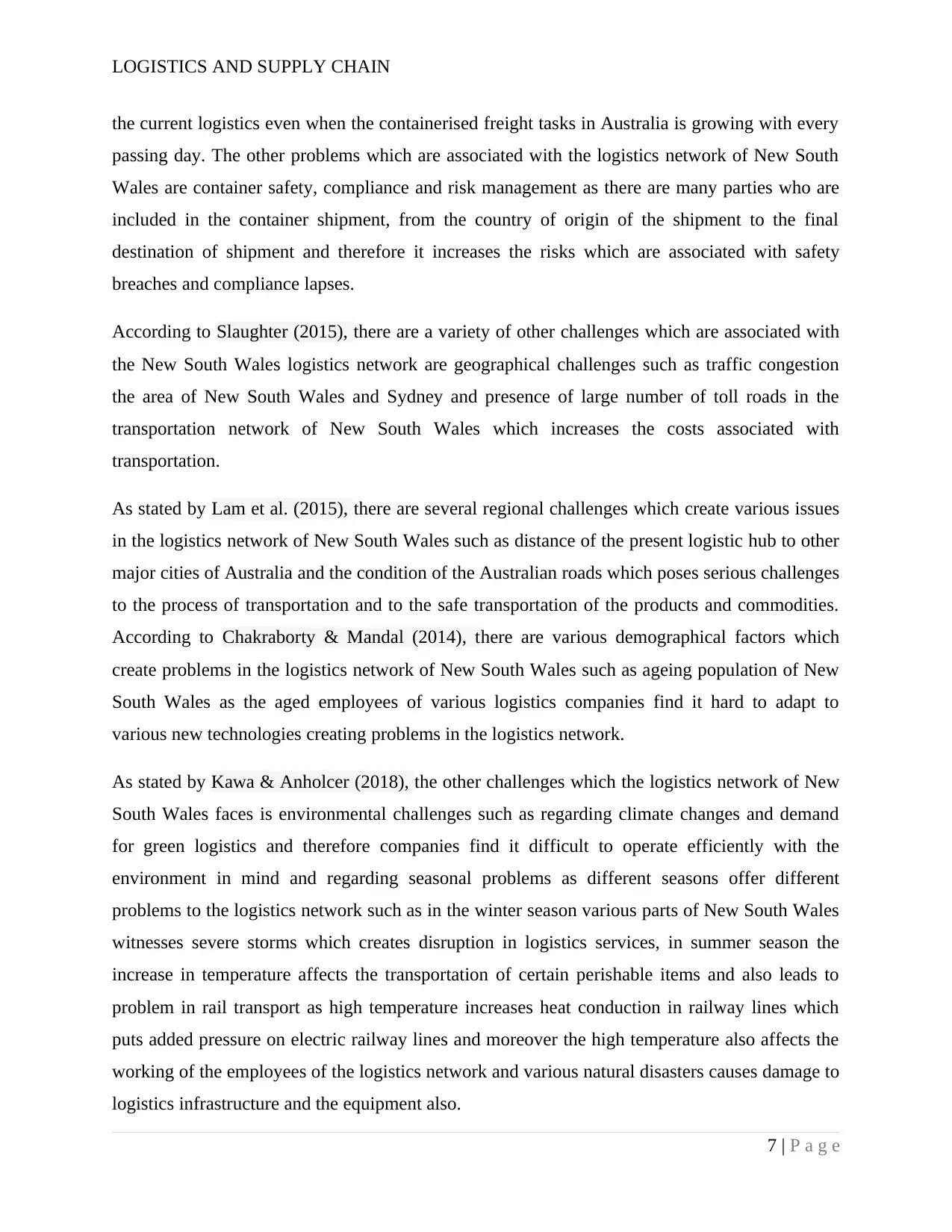
LOGISTICS AND SUPPLY CHAIN
the current logistics even when the containerised freight tasks in Australia is growing with every
passing day. The other problems which are associated with the logistics network of New South
Wales are container safety, compliance and risk management as there are many parties who are
included in the container shipment, from the country of origin of the shipment to the final
destination of shipment and therefore it increases the risks which are associated with safety
breaches and compliance lapses.
According to Slaughter (2015), there are a variety of other challenges which are associated with
the New South Wales logistics network are geographical challenges such as traffic congestion
the area of New South Wales and Sydney and presence of large number of toll roads in the
transportation network of New South Wales which increases the costs associated with
transportation.
As stated by Lam et al. (2015), there are several regional challenges which create various issues
in the logistics network of New South Wales such as distance of the present logistic hub to other
major cities of Australia and the condition of the Australian roads which poses serious challenges
to the process of transportation and to the safe transportation of the products and commodities.
According to Chakraborty & Mandal (2014), there are various demographical factors which
create problems in the logistics network of New South Wales such as ageing population of New
South Wales as the aged employees of various logistics companies find it hard to adapt to
various new technologies creating problems in the logistics network.
As stated by Kawa & Anholcer (2018), the other challenges which the logistics network of New
South Wales faces is environmental challenges such as regarding climate changes and demand
for green logistics and therefore companies find it difficult to operate efficiently with the
environment in mind and regarding seasonal problems as different seasons offer different
problems to the logistics network such as in the winter season various parts of New South Wales
witnesses severe storms which creates disruption in logistics services, in summer season the
increase in temperature affects the transportation of certain perishable items and also leads to
problem in rail transport as high temperature increases heat conduction in railway lines which
puts added pressure on electric railway lines and moreover the high temperature also affects the
working of the employees of the logistics network and various natural disasters causes damage to
logistics infrastructure and the equipment also.
7 | P a g e
the current logistics even when the containerised freight tasks in Australia is growing with every
passing day. The other problems which are associated with the logistics network of New South
Wales are container safety, compliance and risk management as there are many parties who are
included in the container shipment, from the country of origin of the shipment to the final
destination of shipment and therefore it increases the risks which are associated with safety
breaches and compliance lapses.
According to Slaughter (2015), there are a variety of other challenges which are associated with
the New South Wales logistics network are geographical challenges such as traffic congestion
the area of New South Wales and Sydney and presence of large number of toll roads in the
transportation network of New South Wales which increases the costs associated with
transportation.
As stated by Lam et al. (2015), there are several regional challenges which create various issues
in the logistics network of New South Wales such as distance of the present logistic hub to other
major cities of Australia and the condition of the Australian roads which poses serious challenges
to the process of transportation and to the safe transportation of the products and commodities.
According to Chakraborty & Mandal (2014), there are various demographical factors which
create problems in the logistics network of New South Wales such as ageing population of New
South Wales as the aged employees of various logistics companies find it hard to adapt to
various new technologies creating problems in the logistics network.
As stated by Kawa & Anholcer (2018), the other challenges which the logistics network of New
South Wales faces is environmental challenges such as regarding climate changes and demand
for green logistics and therefore companies find it difficult to operate efficiently with the
environment in mind and regarding seasonal problems as different seasons offer different
problems to the logistics network such as in the winter season various parts of New South Wales
witnesses severe storms which creates disruption in logistics services, in summer season the
increase in temperature affects the transportation of certain perishable items and also leads to
problem in rail transport as high temperature increases heat conduction in railway lines which
puts added pressure on electric railway lines and moreover the high temperature also affects the
working of the employees of the logistics network and various natural disasters causes damage to
logistics infrastructure and the equipment also.
7 | P a g e
Paraphrase This Document
Need a fresh take? Get an instant paraphrase of this document with our AI Paraphraser
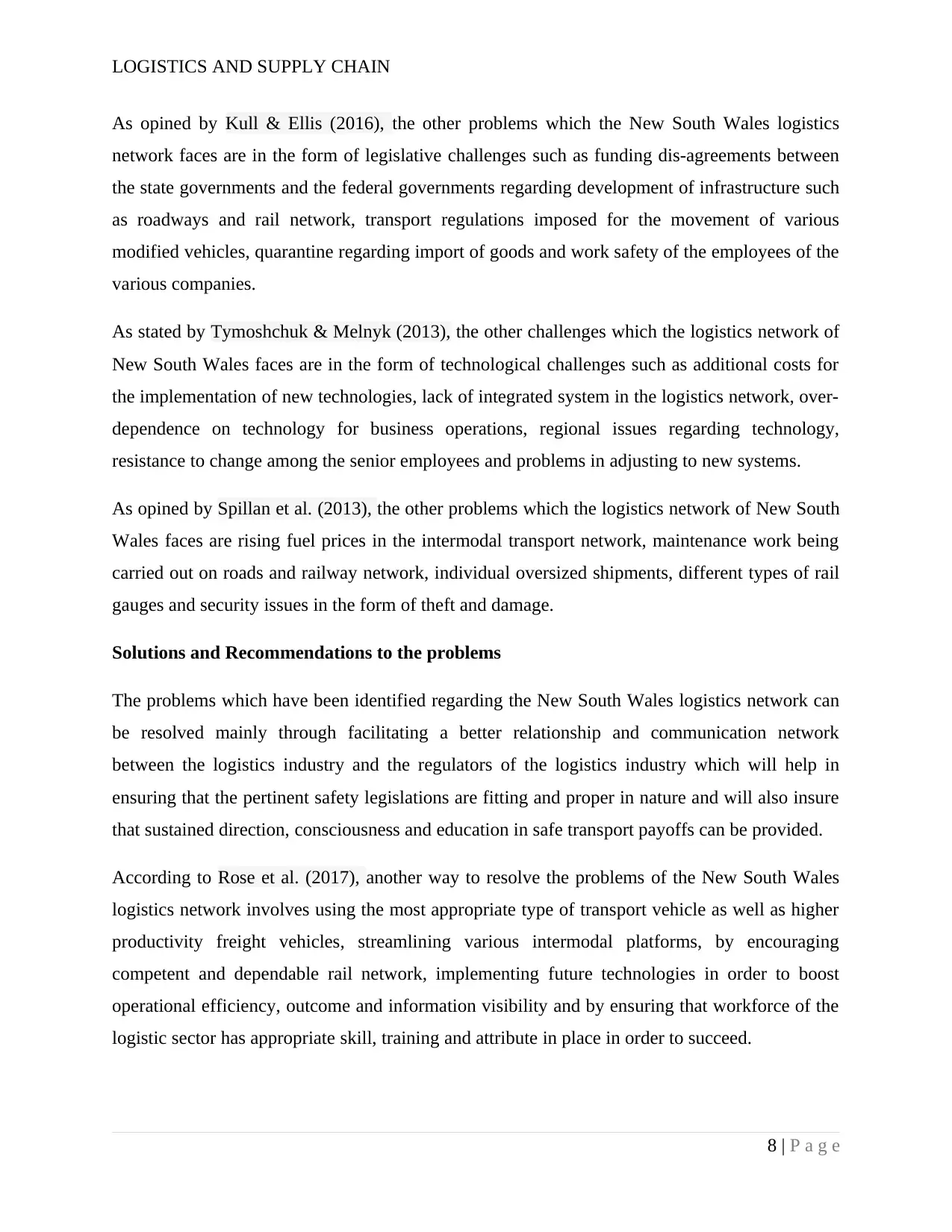
LOGISTICS AND SUPPLY CHAIN
As opined by Kull & Ellis (2016), the other problems which the New South Wales logistics
network faces are in the form of legislative challenges such as funding dis-agreements between
the state governments and the federal governments regarding development of infrastructure such
as roadways and rail network, transport regulations imposed for the movement of various
modified vehicles, quarantine regarding import of goods and work safety of the employees of the
various companies.
As stated by Tymoshchuk & Melnyk (2013), the other challenges which the logistics network of
New South Wales faces are in the form of technological challenges such as additional costs for
the implementation of new technologies, lack of integrated system in the logistics network, over-
dependence on technology for business operations, regional issues regarding technology,
resistance to change among the senior employees and problems in adjusting to new systems.
As opined by Spillan et al. (2013), the other problems which the logistics network of New South
Wales faces are rising fuel prices in the intermodal transport network, maintenance work being
carried out on roads and railway network, individual oversized shipments, different types of rail
gauges and security issues in the form of theft and damage.
Solutions and Recommendations to the problems
The problems which have been identified regarding the New South Wales logistics network can
be resolved mainly through facilitating a better relationship and communication network
between the logistics industry and the regulators of the logistics industry which will help in
ensuring that the pertinent safety legislations are fitting and proper in nature and will also insure
that sustained direction, consciousness and education in safe transport payoffs can be provided.
According to Rose et al. (2017), another way to resolve the problems of the New South Wales
logistics network involves using the most appropriate type of transport vehicle as well as higher
productivity freight vehicles, streamlining various intermodal platforms, by encouraging
competent and dependable rail network, implementing future technologies in order to boost
operational efficiency, outcome and information visibility and by ensuring that workforce of the
logistic sector has appropriate skill, training and attribute in place in order to succeed.
8 | P a g e
As opined by Kull & Ellis (2016), the other problems which the New South Wales logistics
network faces are in the form of legislative challenges such as funding dis-agreements between
the state governments and the federal governments regarding development of infrastructure such
as roadways and rail network, transport regulations imposed for the movement of various
modified vehicles, quarantine regarding import of goods and work safety of the employees of the
various companies.
As stated by Tymoshchuk & Melnyk (2013), the other challenges which the logistics network of
New South Wales faces are in the form of technological challenges such as additional costs for
the implementation of new technologies, lack of integrated system in the logistics network, over-
dependence on technology for business operations, regional issues regarding technology,
resistance to change among the senior employees and problems in adjusting to new systems.
As opined by Spillan et al. (2013), the other problems which the logistics network of New South
Wales faces are rising fuel prices in the intermodal transport network, maintenance work being
carried out on roads and railway network, individual oversized shipments, different types of rail
gauges and security issues in the form of theft and damage.
Solutions and Recommendations to the problems
The problems which have been identified regarding the New South Wales logistics network can
be resolved mainly through facilitating a better relationship and communication network
between the logistics industry and the regulators of the logistics industry which will help in
ensuring that the pertinent safety legislations are fitting and proper in nature and will also insure
that sustained direction, consciousness and education in safe transport payoffs can be provided.
According to Rose et al. (2017), another way to resolve the problems of the New South Wales
logistics network involves using the most appropriate type of transport vehicle as well as higher
productivity freight vehicles, streamlining various intermodal platforms, by encouraging
competent and dependable rail network, implementing future technologies in order to boost
operational efficiency, outcome and information visibility and by ensuring that workforce of the
logistic sector has appropriate skill, training and attribute in place in order to succeed.
8 | P a g e

LOGISTICS AND SUPPLY CHAIN
One of the most effective ways to get rid of the various challenges and issues which are faced by
the New South Wales logistics network is to recruit a young and energetic workforce who will be
better adapt to utilize the benefits of various innovative technologies for the development of the
logistics and will also able to embrace change in a successful manner.
Another effective way to address the various issues faced by the New South Wales logistics
network is to develop the logistics hub or terminal in such a location at New South Wales such as
Moorebank which will aid in the easy receiving of raw materials and transportation of finished
products. New logistics terminal or hub should be developed in such a location which has close
proximity to all modes of transport and are in close proximity with the major cities of Australia.
The new logistics terminal or hub should be built on a large area of land with the ability to
receive and store large quantity of products and should possess several other facilities such as
warehousing, car parking, storm water management etc. The new logistics hub should focus on
gaining various types of approvals from the state governments and also from the federal
government in order to comply with various legal requirements and to promote sustainability.
According to SALANŢĂ & POPA (2015), another way to address the various issues faced by
the New South Wales logistics network is to select the best available transportation option for the
receiving of raw materials and for the delivery of finished products based on the nature of the
raw material or finished products and based on the season as different seasons provide different
challenges for the transportation of goods which disrupts the operations of the logistics network
by increase of transportation costs and damage of goods and materials.
Another Effective way to address the various issues faced by the New South Wales logistics
network is to promote sustainability in the logistics network of the New South Wales as it will
help in reducing the operational costs associated with the receiving and transportation of raw
materials and finished goods through approach of green logistics and it will also help in
increasing the efficiency of the various services offered by the various intermodal network of the
logistics network.
The Role of the government
The NSW state government and the Federal government of Australia have various
responsibilities regarding the development of the logistics network of New South Wales. Firstly
9 | P a g e
One of the most effective ways to get rid of the various challenges and issues which are faced by
the New South Wales logistics network is to recruit a young and energetic workforce who will be
better adapt to utilize the benefits of various innovative technologies for the development of the
logistics and will also able to embrace change in a successful manner.
Another effective way to address the various issues faced by the New South Wales logistics
network is to develop the logistics hub or terminal in such a location at New South Wales such as
Moorebank which will aid in the easy receiving of raw materials and transportation of finished
products. New logistics terminal or hub should be developed in such a location which has close
proximity to all modes of transport and are in close proximity with the major cities of Australia.
The new logistics terminal or hub should be built on a large area of land with the ability to
receive and store large quantity of products and should possess several other facilities such as
warehousing, car parking, storm water management etc. The new logistics hub should focus on
gaining various types of approvals from the state governments and also from the federal
government in order to comply with various legal requirements and to promote sustainability.
According to SALANŢĂ & POPA (2015), another way to address the various issues faced by
the New South Wales logistics network is to select the best available transportation option for the
receiving of raw materials and for the delivery of finished products based on the nature of the
raw material or finished products and based on the season as different seasons provide different
challenges for the transportation of goods which disrupts the operations of the logistics network
by increase of transportation costs and damage of goods and materials.
Another Effective way to address the various issues faced by the New South Wales logistics
network is to promote sustainability in the logistics network of the New South Wales as it will
help in reducing the operational costs associated with the receiving and transportation of raw
materials and finished goods through approach of green logistics and it will also help in
increasing the efficiency of the various services offered by the various intermodal network of the
logistics network.
The Role of the government
The NSW state government and the Federal government of Australia have various
responsibilities regarding the development of the logistics network of New South Wales. Firstly
9 | P a g e
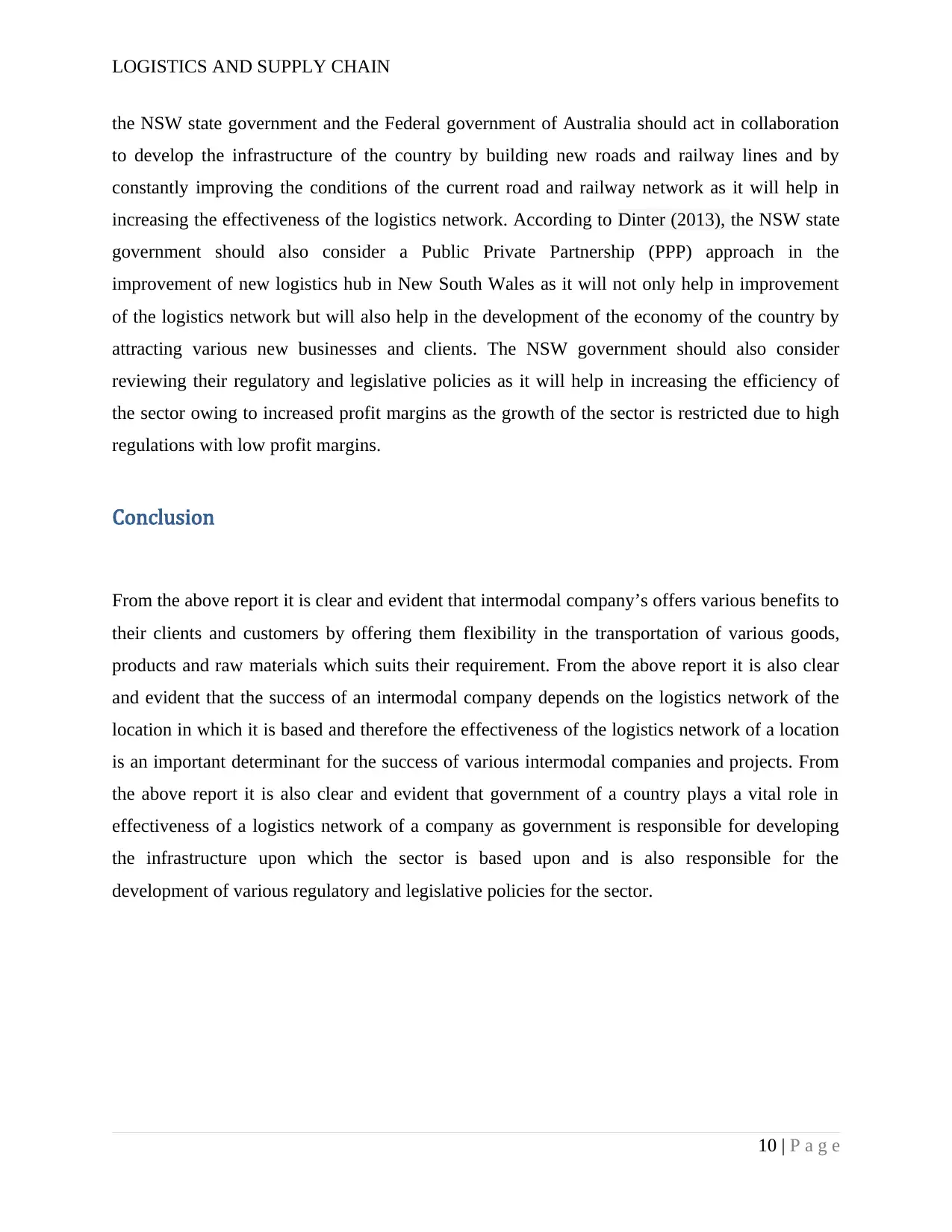
LOGISTICS AND SUPPLY CHAIN
the NSW state government and the Federal government of Australia should act in collaboration
to develop the infrastructure of the country by building new roads and railway lines and by
constantly improving the conditions of the current road and railway network as it will help in
increasing the effectiveness of the logistics network. According to Dinter (2013), the NSW state
government should also consider a Public Private Partnership (PPP) approach in the
improvement of new logistics hub in New South Wales as it will not only help in improvement
of the logistics network but will also help in the development of the economy of the country by
attracting various new businesses and clients. The NSW government should also consider
reviewing their regulatory and legislative policies as it will help in increasing the efficiency of
the sector owing to increased profit margins as the growth of the sector is restricted due to high
regulations with low profit margins.
Conclusion
From the above report it is clear and evident that intermodal company’s offers various benefits to
their clients and customers by offering them flexibility in the transportation of various goods,
products and raw materials which suits their requirement. From the above report it is also clear
and evident that the success of an intermodal company depends on the logistics network of the
location in which it is based and therefore the effectiveness of the logistics network of a location
is an important determinant for the success of various intermodal companies and projects. From
the above report it is also clear and evident that government of a country plays a vital role in
effectiveness of a logistics network of a company as government is responsible for developing
the infrastructure upon which the sector is based upon and is also responsible for the
development of various regulatory and legislative policies for the sector.
10 | P a g e
the NSW state government and the Federal government of Australia should act in collaboration
to develop the infrastructure of the country by building new roads and railway lines and by
constantly improving the conditions of the current road and railway network as it will help in
increasing the effectiveness of the logistics network. According to Dinter (2013), the NSW state
government should also consider a Public Private Partnership (PPP) approach in the
improvement of new logistics hub in New South Wales as it will not only help in improvement
of the logistics network but will also help in the development of the economy of the country by
attracting various new businesses and clients. The NSW government should also consider
reviewing their regulatory and legislative policies as it will help in increasing the efficiency of
the sector owing to increased profit margins as the growth of the sector is restricted due to high
regulations with low profit margins.
Conclusion
From the above report it is clear and evident that intermodal company’s offers various benefits to
their clients and customers by offering them flexibility in the transportation of various goods,
products and raw materials which suits their requirement. From the above report it is also clear
and evident that the success of an intermodal company depends on the logistics network of the
location in which it is based and therefore the effectiveness of the logistics network of a location
is an important determinant for the success of various intermodal companies and projects. From
the above report it is also clear and evident that government of a country plays a vital role in
effectiveness of a logistics network of a company as government is responsible for developing
the infrastructure upon which the sector is based upon and is also responsible for the
development of various regulatory and legislative policies for the sector.
10 | P a g e
Secure Best Marks with AI Grader
Need help grading? Try our AI Grader for instant feedback on your assignments.
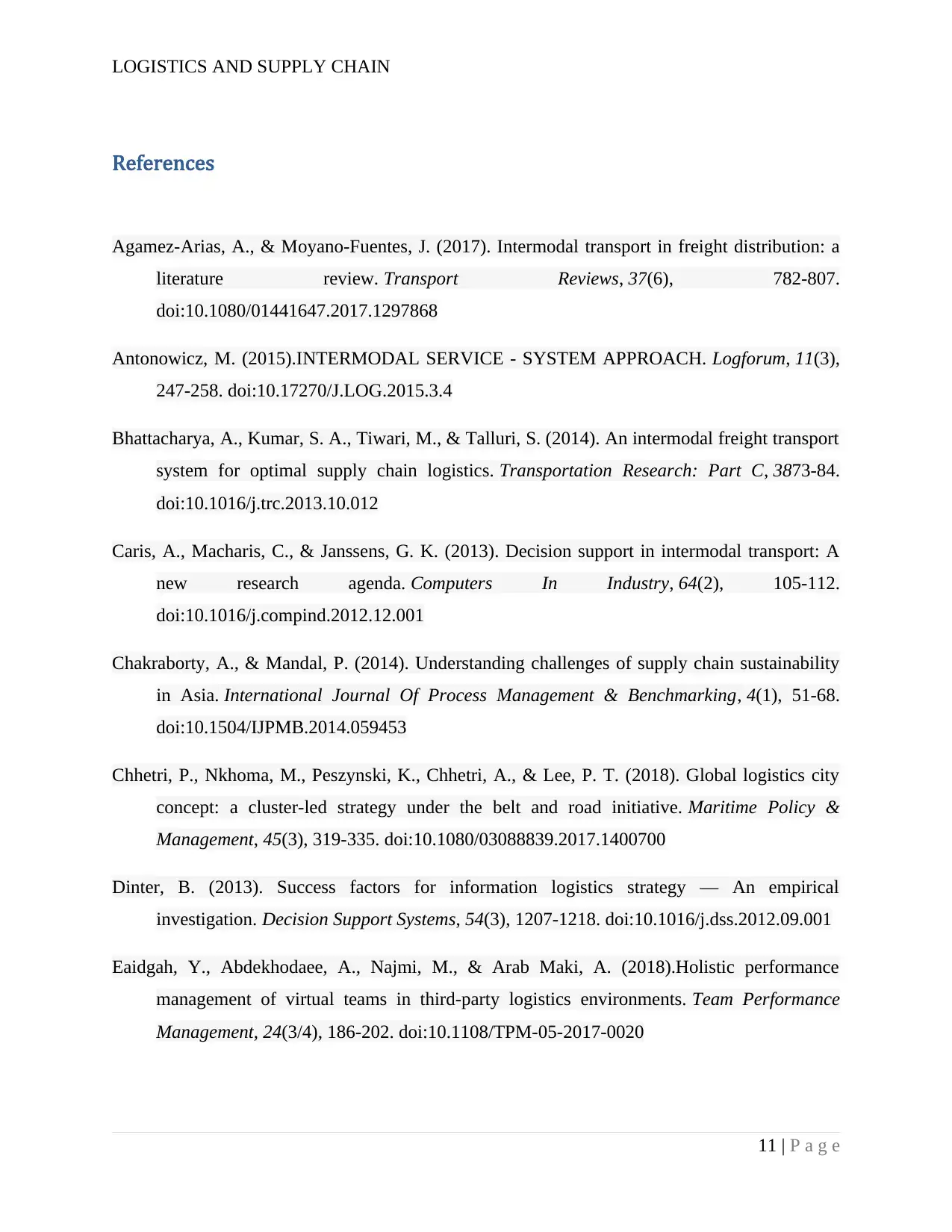
LOGISTICS AND SUPPLY CHAIN
References
Agamez-Arias, A., & Moyano-Fuentes, J. (2017). Intermodal transport in freight distribution: a
literature review. Transport Reviews, 37(6), 782-807.
doi:10.1080/01441647.2017.1297868
Antonowicz, M. (2015).INTERMODAL SERVICE - SYSTEM APPROACH. Logforum, 11(3),
247-258. doi:10.17270/J.LOG.2015.3.4
Bhattacharya, A., Kumar, S. A., Tiwari, M., & Talluri, S. (2014). An intermodal freight transport
system for optimal supply chain logistics. Transportation Research: Part C, 3873-84.
doi:10.1016/j.trc.2013.10.012
Caris, A., Macharis, C., & Janssens, G. K. (2013). Decision support in intermodal transport: A
new research agenda. Computers In Industry, 64(2), 105-112.
doi:10.1016/j.compind.2012.12.001
Chakraborty, A., & Mandal, P. (2014). Understanding challenges of supply chain sustainability
in Asia. International Journal Of Process Management & Benchmarking, 4(1), 51-68.
doi:10.1504/IJPMB.2014.059453
Chhetri, P., Nkhoma, M., Peszynski, K., Chhetri, A., & Lee, P. T. (2018). Global logistics city
concept: a cluster-led strategy under the belt and road initiative. Maritime Policy &
Management, 45(3), 319-335. doi:10.1080/03088839.2017.1400700
Dinter, B. (2013). Success factors for information logistics strategy — An empirical
investigation. Decision Support Systems, 54(3), 1207-1218. doi:10.1016/j.dss.2012.09.001
Eaidgah, Y., Abdekhodaee, A., Najmi, M., & Arab Maki, A. (2018).Holistic performance
management of virtual teams in third-party logistics environments. Team Performance
Management, 24(3/4), 186-202. doi:10.1108/TPM-05-2017-0020
11 | P a g e
References
Agamez-Arias, A., & Moyano-Fuentes, J. (2017). Intermodal transport in freight distribution: a
literature review. Transport Reviews, 37(6), 782-807.
doi:10.1080/01441647.2017.1297868
Antonowicz, M. (2015).INTERMODAL SERVICE - SYSTEM APPROACH. Logforum, 11(3),
247-258. doi:10.17270/J.LOG.2015.3.4
Bhattacharya, A., Kumar, S. A., Tiwari, M., & Talluri, S. (2014). An intermodal freight transport
system for optimal supply chain logistics. Transportation Research: Part C, 3873-84.
doi:10.1016/j.trc.2013.10.012
Caris, A., Macharis, C., & Janssens, G. K. (2013). Decision support in intermodal transport: A
new research agenda. Computers In Industry, 64(2), 105-112.
doi:10.1016/j.compind.2012.12.001
Chakraborty, A., & Mandal, P. (2014). Understanding challenges of supply chain sustainability
in Asia. International Journal Of Process Management & Benchmarking, 4(1), 51-68.
doi:10.1504/IJPMB.2014.059453
Chhetri, P., Nkhoma, M., Peszynski, K., Chhetri, A., & Lee, P. T. (2018). Global logistics city
concept: a cluster-led strategy under the belt and road initiative. Maritime Policy &
Management, 45(3), 319-335. doi:10.1080/03088839.2017.1400700
Dinter, B. (2013). Success factors for information logistics strategy — An empirical
investigation. Decision Support Systems, 54(3), 1207-1218. doi:10.1016/j.dss.2012.09.001
Eaidgah, Y., Abdekhodaee, A., Najmi, M., & Arab Maki, A. (2018).Holistic performance
management of virtual teams in third-party logistics environments. Team Performance
Management, 24(3/4), 186-202. doi:10.1108/TPM-05-2017-0020
11 | P a g e
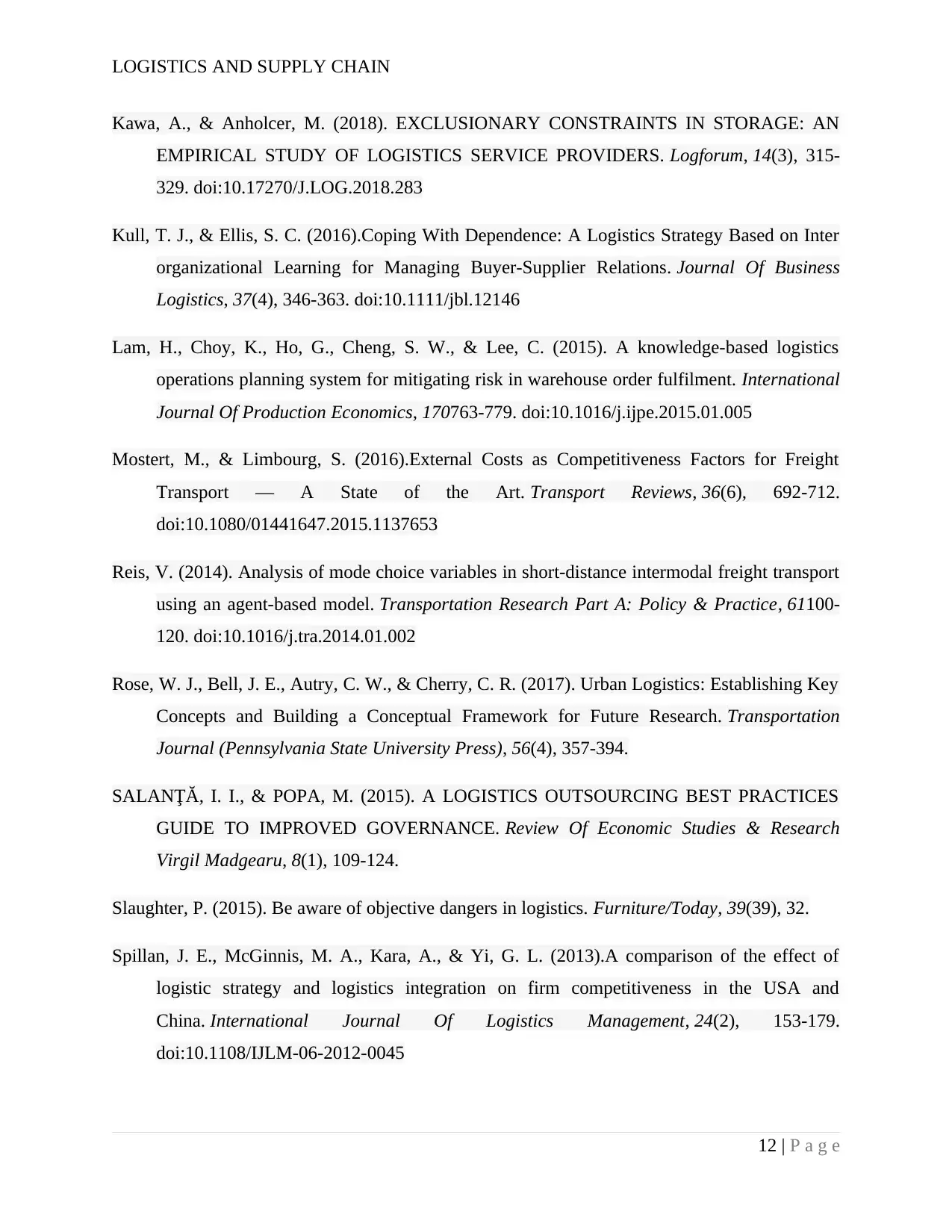
LOGISTICS AND SUPPLY CHAIN
Kawa, A., & Anholcer, M. (2018). EXCLUSIONARY CONSTRAINTS IN STORAGE: AN
EMPIRICAL STUDY OF LOGISTICS SERVICE PROVIDERS. Logforum, 14(3), 315-
329. doi:10.17270/J.LOG.2018.283
Kull, T. J., & Ellis, S. C. (2016).Coping With Dependence: A Logistics Strategy Based on Inter
organizational Learning for Managing Buyer-Supplier Relations. Journal Of Business
Logistics, 37(4), 346-363. doi:10.1111/jbl.12146
Lam, H., Choy, K., Ho, G., Cheng, S. W., & Lee, C. (2015). A knowledge-based logistics
operations planning system for mitigating risk in warehouse order fulfilment. International
Journal Of Production Economics, 170763-779. doi:10.1016/j.ijpe.2015.01.005
Mostert, M., & Limbourg, S. (2016).External Costs as Competitiveness Factors for Freight
Transport — A State of the Art. Transport Reviews, 36(6), 692-712.
doi:10.1080/01441647.2015.1137653
Reis, V. (2014). Analysis of mode choice variables in short-distance intermodal freight transport
using an agent-based model. Transportation Research Part A: Policy & Practice, 61100-
120. doi:10.1016/j.tra.2014.01.002
Rose, W. J., Bell, J. E., Autry, C. W., & Cherry, C. R. (2017). Urban Logistics: Establishing Key
Concepts and Building a Conceptual Framework for Future Research. Transportation
Journal (Pennsylvania State University Press), 56(4), 357-394.
SALANŢĂ, I. I., & POPA, M. (2015). A LOGISTICS OUTSOURCING BEST PRACTICES
GUIDE TO IMPROVED GOVERNANCE. Review Of Economic Studies & Research
Virgil Madgearu, 8(1), 109-124.
Slaughter, P. (2015). Be aware of objective dangers in logistics. Furniture/Today, 39(39), 32.
Spillan, J. E., McGinnis, M. A., Kara, A., & Yi, G. L. (2013).A comparison of the effect of
logistic strategy and logistics integration on firm competitiveness in the USA and
China. International Journal Of Logistics Management, 24(2), 153-179.
doi:10.1108/IJLM-06-2012-0045
12 | P a g e
Kawa, A., & Anholcer, M. (2018). EXCLUSIONARY CONSTRAINTS IN STORAGE: AN
EMPIRICAL STUDY OF LOGISTICS SERVICE PROVIDERS. Logforum, 14(3), 315-
329. doi:10.17270/J.LOG.2018.283
Kull, T. J., & Ellis, S. C. (2016).Coping With Dependence: A Logistics Strategy Based on Inter
organizational Learning for Managing Buyer-Supplier Relations. Journal Of Business
Logistics, 37(4), 346-363. doi:10.1111/jbl.12146
Lam, H., Choy, K., Ho, G., Cheng, S. W., & Lee, C. (2015). A knowledge-based logistics
operations planning system for mitigating risk in warehouse order fulfilment. International
Journal Of Production Economics, 170763-779. doi:10.1016/j.ijpe.2015.01.005
Mostert, M., & Limbourg, S. (2016).External Costs as Competitiveness Factors for Freight
Transport — A State of the Art. Transport Reviews, 36(6), 692-712.
doi:10.1080/01441647.2015.1137653
Reis, V. (2014). Analysis of mode choice variables in short-distance intermodal freight transport
using an agent-based model. Transportation Research Part A: Policy & Practice, 61100-
120. doi:10.1016/j.tra.2014.01.002
Rose, W. J., Bell, J. E., Autry, C. W., & Cherry, C. R. (2017). Urban Logistics: Establishing Key
Concepts and Building a Conceptual Framework for Future Research. Transportation
Journal (Pennsylvania State University Press), 56(4), 357-394.
SALANŢĂ, I. I., & POPA, M. (2015). A LOGISTICS OUTSOURCING BEST PRACTICES
GUIDE TO IMPROVED GOVERNANCE. Review Of Economic Studies & Research
Virgil Madgearu, 8(1), 109-124.
Slaughter, P. (2015). Be aware of objective dangers in logistics. Furniture/Today, 39(39), 32.
Spillan, J. E., McGinnis, M. A., Kara, A., & Yi, G. L. (2013).A comparison of the effect of
logistic strategy and logistics integration on firm competitiveness in the USA and
China. International Journal Of Logistics Management, 24(2), 153-179.
doi:10.1108/IJLM-06-2012-0045
12 | P a g e
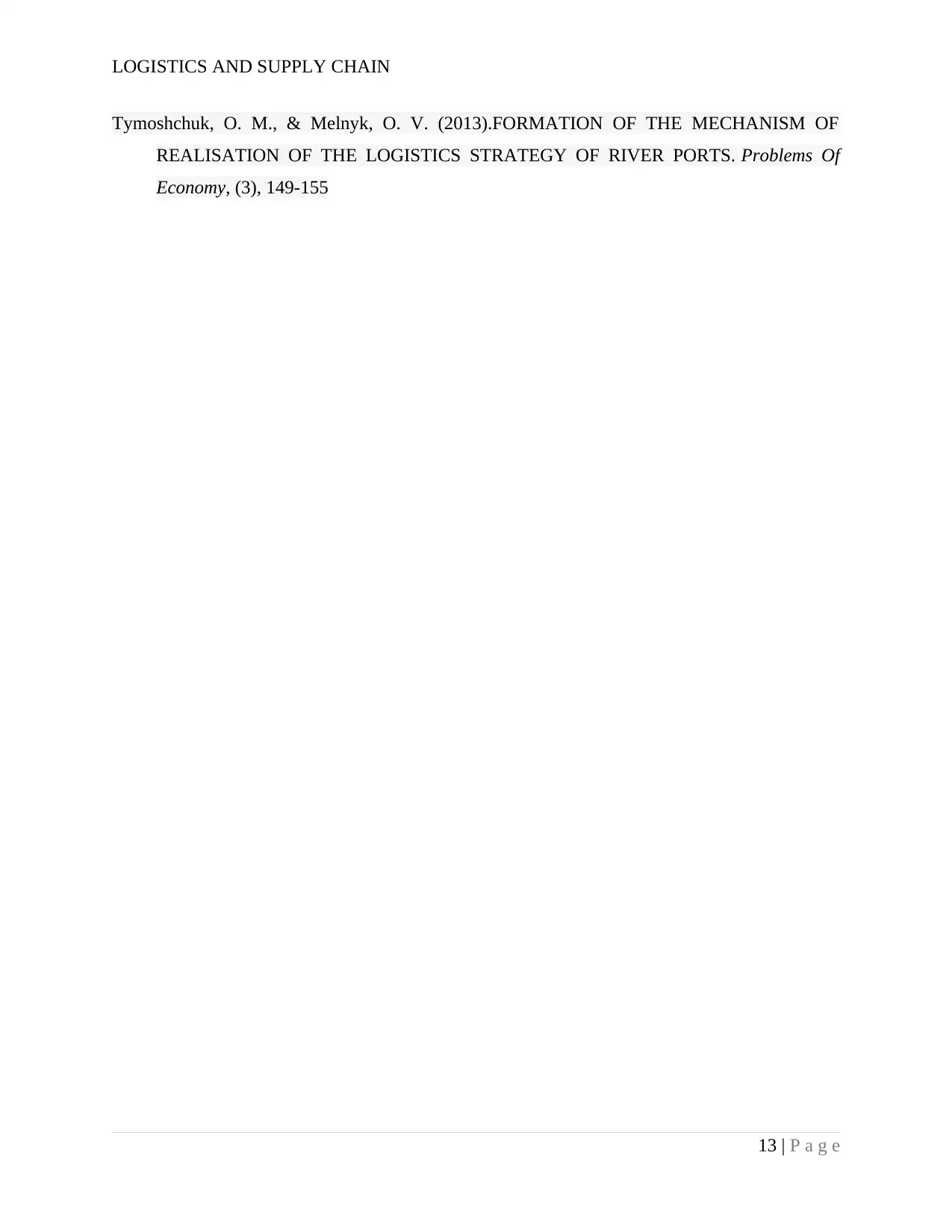
LOGISTICS AND SUPPLY CHAIN
Tymoshchuk, O. M., & Melnyk, O. V. (2013).FORMATION OF THE MECHANISM OF
REALISATION OF THE LOGISTICS STRATEGY OF RIVER PORTS. Problems Of
Economy, (3), 149-155
13 | P a g e
Tymoshchuk, O. M., & Melnyk, O. V. (2013).FORMATION OF THE MECHANISM OF
REALISATION OF THE LOGISTICS STRATEGY OF RIVER PORTS. Problems Of
Economy, (3), 149-155
13 | P a g e
1 out of 13
Related Documents
Your All-in-One AI-Powered Toolkit for Academic Success.
+13062052269
info@desklib.com
Available 24*7 on WhatsApp / Email
![[object Object]](/_next/static/media/star-bottom.7253800d.svg)
Unlock your academic potential
© 2024 | Zucol Services PVT LTD | All rights reserved.





